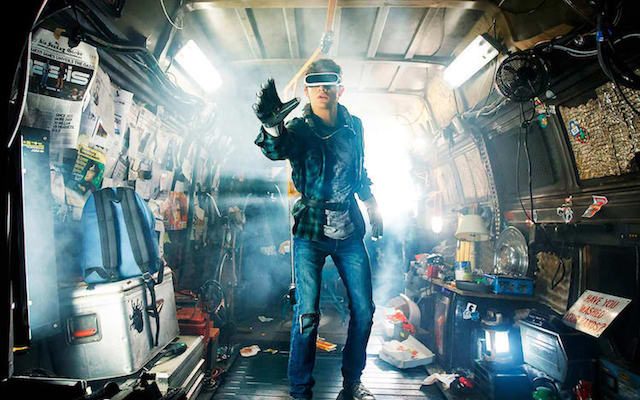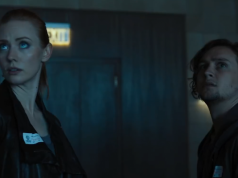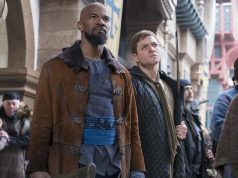
“Ready Player One” is set in a future where people spend most of their time in a virtual-reality world called OASIS that allows them to play games and have adventures in whatever fictional settings and with whatever fictional characters they choose (provided the filmmakers could get the rights). Our hero, 18-year-old Wade (Tye Sheridan), tells us real life is so drab that, apart from bathroom breaks and sleep, a lot of folks basically live in the OASIS and have most of their social interaction there. For all intents and purposes, it is their world.
The problem with “Ready Player One” is that the OASIS is not our world. To us (or to me, anyway; I can’t speak for you) it’s just a cool game with a lot of options, being played by people who are not us. No matter how valuable it is to Wade and his fellow denizens of the year 2045, and no matter how vividly it’s created by director Steven Spielberg, it’s not actually real to them. For us it’s even less real — a fake world inside of a fake world.
So what happens when that fake world is threatened? I don’t care, that’s what.
The premise is that the designer of the OASIS, a soft-spoken space cadet named Halliday (Mark Rylance), hid a contest inside of it in the form of three challenges that must be discovered and conquered. Whoever does this first will win the now-deceased Halliday’s half-trillion-dollar fortune and ownership of the OASIS. Five years on, Wade is one of a handful of ordinary people still pursuing this goal, joined by his in-game friends, whom he’s never met in real life but who coincidentally live in his neighborhood.
Their main competition is a video game company called IOI, the second largest corporation in the world (behind Halliday’s) with an eye toward being the first. Headed by malevolent ignoramus Nolan Sorrento (Ben Mendelsohn), the sort of n00b who writes his password on a Post-It note, IOI has an army of staffers called Sixers working round-the-clock to scour every corner of OASIS in search of Halliday’s challenges. Where normal players’ ability to re-enter the game after being “zeroed out” (losing all of one’s points; “dying”) depends on their ability to buy credits (which cost real-world money), the Sixers, with their corporate backing, basically have unlimited lives.
What’s more, IOI has a staff of nerds whose only job is to search Halliday’s digitized memories, journals, and other resources for clues as to where in the OASIS he might have hidden the challenges. This requires them to be experts in pop culture of the 1980s, the decade Halliday grew up in and the source of most of his personality– er, references. The widespread popularity of the OASIS means lots of average joes are also inordinately knowledgeable about the ’80s. For a viewer who grew up in the ’80s and has already been through an ’80s nostalgia phase, this might get old pretty fast.
Wade’s avatar is a blond Timothee Chalamet type named Parzival. A hulking beast called Aech (Lena Waithe) — pronounced “H” — is his best friend, and they’re soon joined by a new girl, Art3mis (Olivia Cooke), for whom Wade develops the hots. There are two more, Sho (Philip Zhao) and Daito (Win Morisaki), who play no significant role in the story except to give the group five members so they can be called the High Five (because they score high, not because they are high). When Wade and the gang start making progress on the challenges, Sorrento takes note and targets them directly, sending a mercenary named I-R0k (T.J. Miller) to kill their avatars.
What little we see of the real world of 2045 suggests it’s overcrowded and polluted but not dystopian. There was no apocalypse. People continue to live and work and order Pizza Hut (delivered by drones). IOI owns debtors’ prisons called “Loyalty Centers” where people work off what they owe by serving as Sixers, a system that no doubt needs regulatory oversight and is dangerously close to slavery. But in general, and in spite of the ’80s fixation, real life isn’t a living hell.
Having shown us this unappealing but not hopeless real world, the movie then spends most of its time in a digital world where people are represented by computer-generated avatars. This creates emotional distance — it’s hard to feel connected to animated beings when we know their flesh-and-blood counterparts are out there — and lowers the stakes of the story: None of this is real. It’s not even a “you die in the game, you die in real life” situation. If you die in the game and can’t afford to buy back in, the only consequence is that you can’t play the game anymore.
This problem of low stakes drags down the entire film. Wade and his friends don’t just want to win the game, they want to prevent IOI from winning. Why would it be disastrous if IOI controlled the OASIS? Because they’d fill it with ads. They would ruin everything — everything in this fake computer world, that is. Real life would continue as before.
No matter how much fun your game is, I don’t care if it gets destroyed. I mean, maybe I can care for the length of a TV episode. But I don’t two-hours-and-twenty-minutes care.
It doesn’t help that Wade is a bland hero whose only motivation seems to be that it’s a game with a prize at the end. There is much good he could do with the money if he wins, but we never get the impression that that’s WHY he’s doing it. So we have a guy who’s on a quest for no particular reason, where if he fails nothing particularly bad will happen. The film tries to up the ante by having Sorrento come after Wade’s real-world guardian, Aunt Alice (Susan Lynch), a character we barely met to whom Wade isn’t especially attached, but somehow that fails to generate sympathy.
The Ernest Cline novel this is based on is so full of ’80s pop-culture references that it became the subject of mockery. The movie, adapted by Cline and Zak Penn, has to show them rather than just rattle them off, so plenty of Generation X memorabilia whizzes across the screen without drawing attention to itself. There’s an auto race that’s vintage Spielberg, the players speeding through a dizzying course in “Back to the Future” DeLoreans and other vehicles that you’d recognize from other movies if you could pause the action and look, with figures like Freddy Krueger and Jason Voorhees appearing in the periphery as other players’ avatars. The more overt references, the ones openly discussed and encountered by the characters, tend to be from properties owned by “Ready Player One” distributor Warner Bros. and don’t necessarily fit the book’s John Hughes and Atari vibe — “The Shining” and “The Iron Giant,” for example.
The film is thus busy and hectic but not cohesive, a game that’s nothing more than a game. There are moments of Spielbergian delight; fine, hammy performances by Mark Rylance and Ben Mendelsohn; and terrific visuals. But it’s all (to borrow a slightly older reference) full of sound and fury and signifying nothing.
C (2 hrs., 20 min.; )





